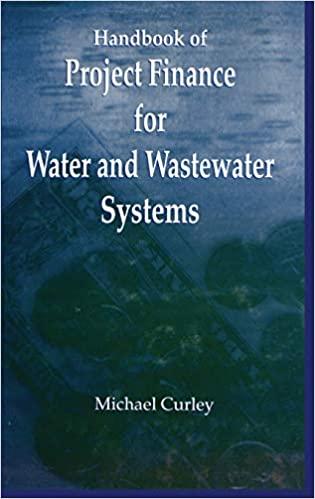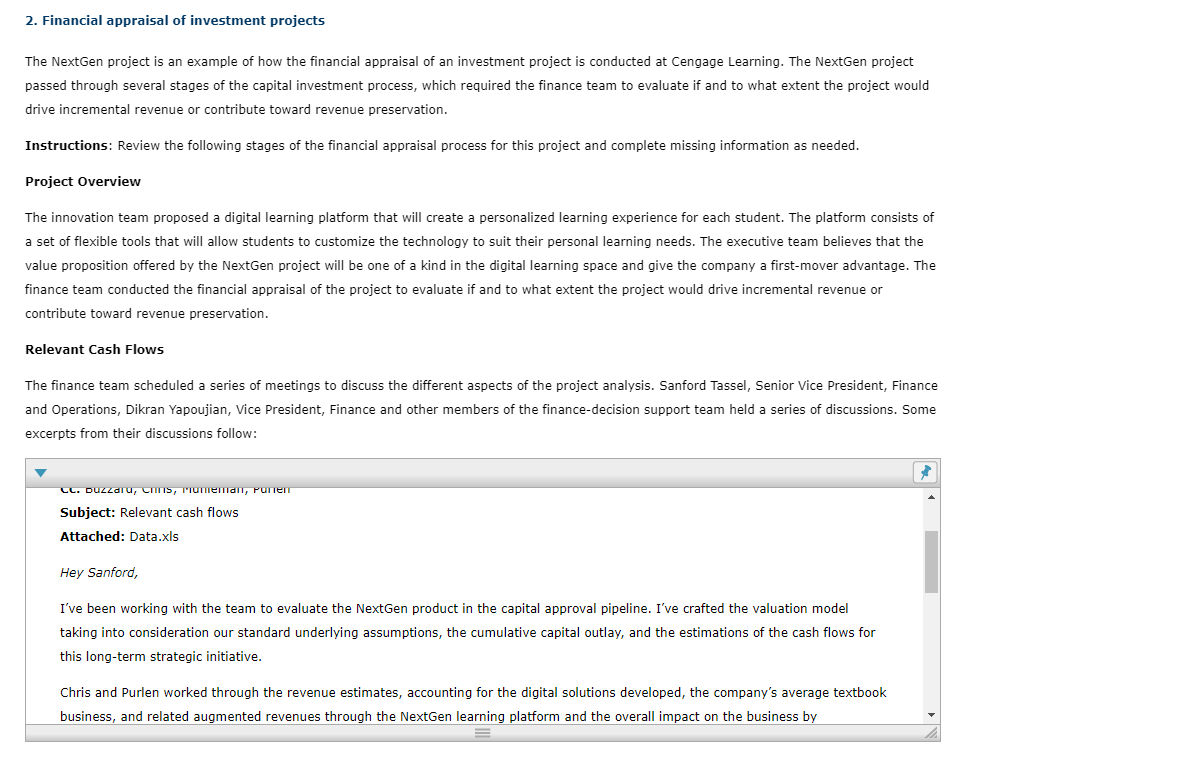

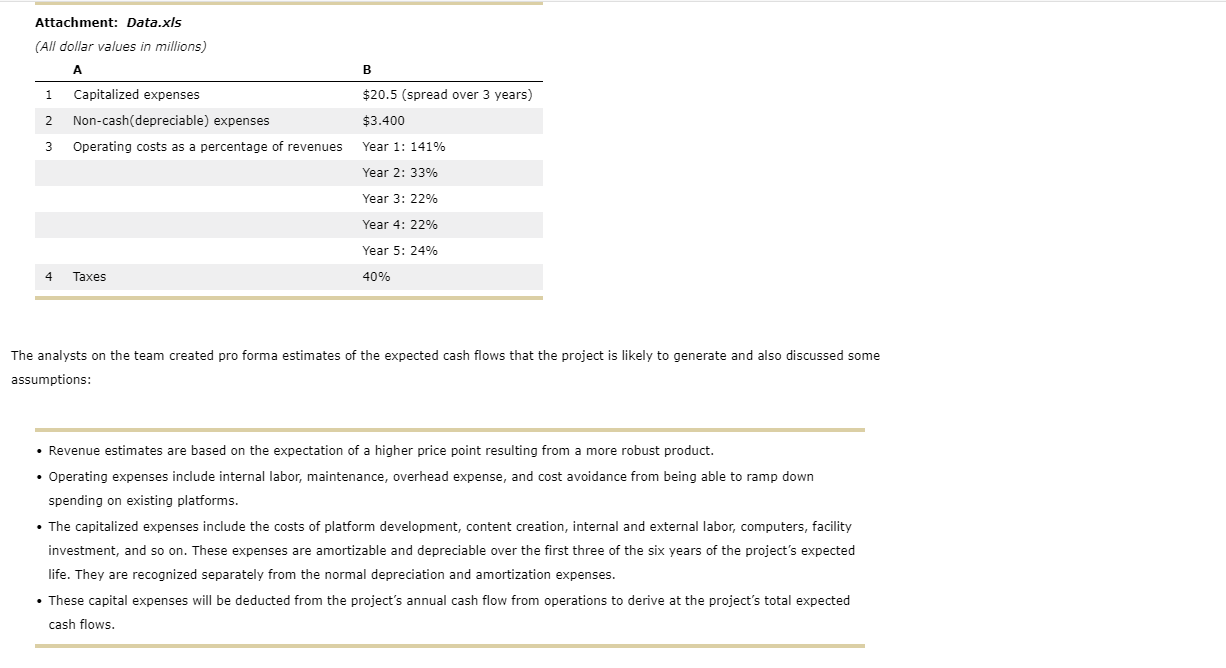
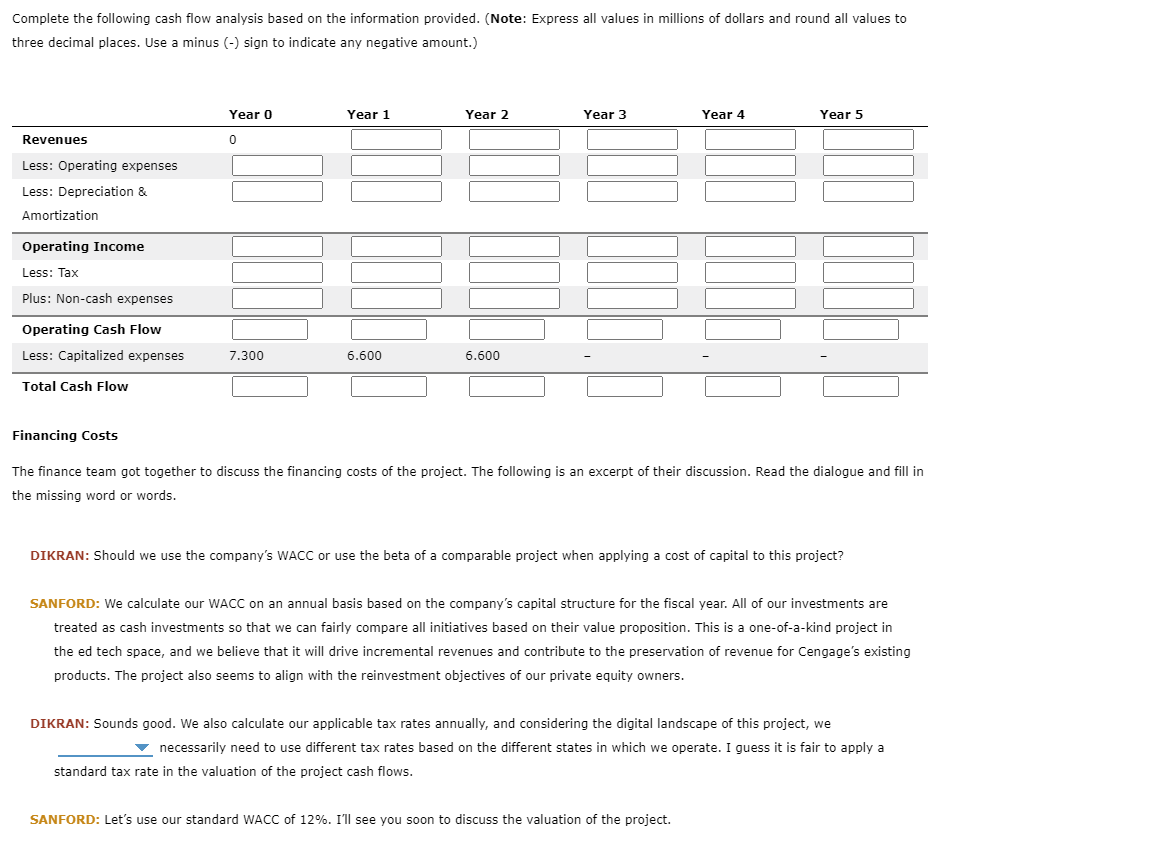
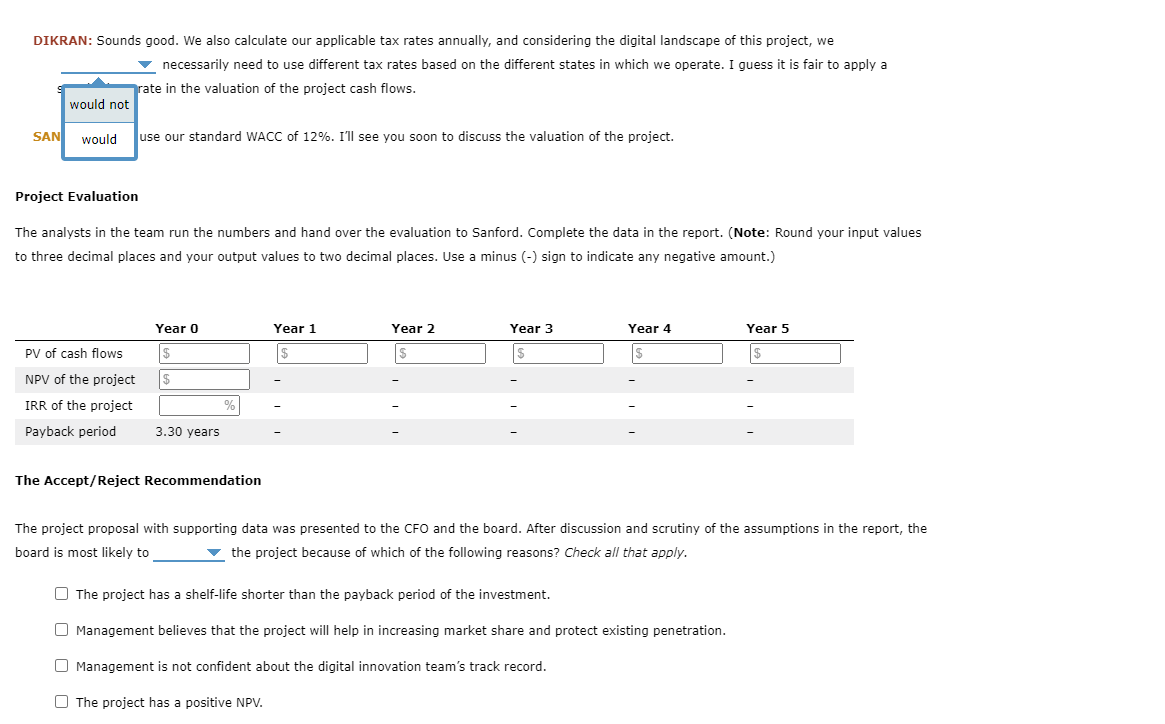
2. Financial appraisal of investment projects The NextGen project is an example of how the financial appraisal of an investment project is conducted at Cengage Learning. The NextGen project passed through several stages of the capital investment process, which required the finance team to evaluate if and to what extent the project would drive incremental revenue or contribute toward revenue preservation. Instructions: Review the following stages of the financial appraisal process for this project and complete missing information as needed. Project Overview The innovation team proposed a digital learning platform that will create a personalized learning experience for each student. The platform consists of a set of flexible tools that will allow students to customize the technology to suit their personal learning needs. The executive team believes that the value proposition offered by the NextGen project will be one of a kind in the digital learning space and give the company a first-mover advantage. The finance team conducted the financial appraisal of the project to evaluate if and to what extent the project would drive incremental revenue or contribute toward revenue preservation. Relevant Cash Flows The finance team scheduled a series of meetings to discuss the different aspects of the project analysis. Sanford Tassel, Senior Vice President, Finance and Operations, Dikran Yapoujian, Vice President, Finance and other members of the finance-decision support team held a series of discussions. Some excerpts from their discussions follow: CC. Duzzaru, Chis, Iurretan, Puntem Subject: Relevant cash flows Attached: Data.xls Hey Sanford, I've been working with the team to evaluate the NextGen product in the capital approval pipeline. I've crafted the valuation model taking into consideration our standard underlying assumptions, the cumulative capital outlay, and the estimations of the cash flows for this long-term strategic initiative. Chris and Purlen worked through the revenue estimates, accounting for the digital solutions developed, the company's average textbook business, and related augmented revenues through the NextGen learning platform and the overall impact on the business by Here are my thoughts: In addition to being strategic to Cengage, the project seems viable economically. The technology used in the project is evolutionary in nature, restricting us to work with a relevant time horizon of six years and to ignore any cash flows after the sixth year. We would need to immediately approve a capital allocation of $1.70 million to jump-start the project. In addition, we would need to capitalize another $20.5 million almost equally for the next three years. These expenses will be incurred on an after-tax basis. The first year of the project is unlikely to bring any additional revenues, but from second year, we should see revenues increase by $1.800 million. Our preliminary estimates also show revenues growing to $9.700 million in year 2, $19.300 million in year 3, $22.800 million in year 4, and $24.600 million in year 5. Attachment: Data.xls (All dollar values in millions) B 1 Capitalized expenses $20.5 (spread over 3 years) $3.400 2 Non-cash(depreciable) expenses Operating costs as a percentage of revenues 3 Year 1: 141% Year 2: 33% Year 3: 22% Year 4: 22% Year 5: 24% 4 Taxes 40% The analysts on the team created pro forma estimates of the expected cash flows that the project is likely to generate and also discussed some assumptions: Revenue estimates are based on the expectation of a higher price point resulting from a more robust product. Operating expenses include internal labor, maintenance, overhead expense, and cost avoidance from being able to ramp down spending on existing platforms. The capitalized expenses include the costs of platform development, content creation, internal and external labor, computers, facility investment, and so on. These expenses are amortizable and depreciable over the first three of the six years of the project's expected life. They are recognized separately from the normal depreciation and amortization expenses. These capital expenses will be deducted from the project's annual cash flow from operations to derive at the project's total expected cash flows. Complete the following cash flow analysis based on the information provided. (Note: Express all values in millions of dollars and round all values to three decimal places. Use a minus (-) sign to indicate any negative amount.) Year o Year 1 Year 2 Year 3 Year 4 Year 5 Revenues 0 Less: Operating expenses Less: Depreciation & Amortization Operating Income Less: Tax Plus: Non-cash expenses Operating Cash Flow Less: Capitalized expenses 7.300 6.600 6.600 Total Cash Flow Financing Costs The finance team got together to discuss the financing costs of the project. The following is an excerpt of their discussion. Read the dialogue and fill in the missing word or words. DIKRAN: Should we use the company's WACC or use the beta of a comparable project when applying a cost of capital to this project? SANFORD: We calculate our WACC on an annual basis based on the company's capital structure for the fiscal year. All of our investments are treated as cash investments so that we can fairly compare all initiatives based on their value proposition. This is a one-of-a-kind project in the ed tech space, and we believe that it will drive incremental revenues and contribute to the preservation of revenue for Cengage's existing products. The project also seems to align with the reinvestment objectives of our private equity owners. DIKRAN: Sounds good. We also calculate our applicable tax rates annually, and considering the digital landscape of this project, we necessarily need to use different tax rates based on the different states in which we operate. I guess it is fair to apply a standard tax rate in the valuation of the project cash flows. SANFORD: Let's use our standard WACC of 12%. I'll see you soon to discuss the valuation of the project. DIKRAN: Sounds good. We also calculate our applicable tax rates annually, and considering the digital landscape of this project, we necessarily need to use different tax rates based on the different states in which we operate. I guess it is fair to apply a rate in the valuation of the project cash flows. would not SAN would use our standard WACC of 12%. I'll see you soon to discuss the valuation of the project. Project Evaluation The analysts in the team run the numbers and hand over the evaluation to Sanford. Complete the data in the report. (Note: Round your input values to three decimal places and your output values to two decimal places. Use a minus (-) sign to indicate any negative amount.) Year o Year 1 Year 2 Year 3 Year 4 Year 5 PV of cash flows $ NPV of the project IRR of the project % Payback period 3.30 years The Accept/Reject Recommendation The project proposal with supporting data was presented to the CFO and the board. After discussion and scrutiny of the assumptions in the report, the board is most likely to the project because of which of the following reasons? Check all that apply. The project has a shelf-life shorter than the payback period of the investment. Management believes that the project will help in increasing market share and protect existing penetration. Management is not confident about the digital innovation team's track record. The project has a positive NPV. 2. Financial appraisal of investment projects The NextGen project is an example of how the financial appraisal of an investment project is conducted at Cengage Learning. The NextGen project passed through several stages of the capital investment process, which required the finance team to evaluate if and to what extent the project would drive incremental revenue or contribute toward revenue preservation. Instructions: Review the following stages of the financial appraisal process for this project and complete missing information as needed. Project Overview The innovation team proposed a digital learning platform that will create a personalized learning experience for each student. The platform consists of a set of flexible tools that will allow students to customize the technology to suit their personal learning needs. The executive team believes that the value proposition offered by the NextGen project will be one of a kind in the digital learning space and give the company a first-mover advantage. The finance team conducted the financial appraisal of the project to evaluate if and to what extent the project would drive incremental revenue or contribute toward revenue preservation. Relevant Cash Flows The finance team scheduled a series of meetings to discuss the different aspects of the project analysis. Sanford Tassel, Senior Vice President, Finance and Operations, Dikran Yapoujian, Vice President, Finance and other members of the finance-decision support team held a series of discussions. Some excerpts from their discussions follow: CC. Duzzaru, Chis, Iurretan, Puntem Subject: Relevant cash flows Attached: Data.xls Hey Sanford, I've been working with the team to evaluate the NextGen product in the capital approval pipeline. I've crafted the valuation model taking into consideration our standard underlying assumptions, the cumulative capital outlay, and the estimations of the cash flows for this long-term strategic initiative. Chris and Purlen worked through the revenue estimates, accounting for the digital solutions developed, the company's average textbook business, and related augmented revenues through the NextGen learning platform and the overall impact on the business by Here are my thoughts: In addition to being strategic to Cengage, the project seems viable economically. The technology used in the project is evolutionary in nature, restricting us to work with a relevant time horizon of six years and to ignore any cash flows after the sixth year. We would need to immediately approve a capital allocation of $1.70 million to jump-start the project. In addition, we would need to capitalize another $20.5 million almost equally for the next three years. These expenses will be incurred on an after-tax basis. The first year of the project is unlikely to bring any additional revenues, but from second year, we should see revenues increase by $1.800 million. Our preliminary estimates also show revenues growing to $9.700 million in year 2, $19.300 million in year 3, $22.800 million in year 4, and $24.600 million in year 5. Attachment: Data.xls (All dollar values in millions) B 1 Capitalized expenses $20.5 (spread over 3 years) $3.400 2 Non-cash(depreciable) expenses Operating costs as a percentage of revenues 3 Year 1: 141% Year 2: 33% Year 3: 22% Year 4: 22% Year 5: 24% 4 Taxes 40% The analysts on the team created pro forma estimates of the expected cash flows that the project is likely to generate and also discussed some assumptions: Revenue estimates are based on the expectation of a higher price point resulting from a more robust product. Operating expenses include internal labor, maintenance, overhead expense, and cost avoidance from being able to ramp down spending on existing platforms. The capitalized expenses include the costs of platform development, content creation, internal and external labor, computers, facility investment, and so on. These expenses are amortizable and depreciable over the first three of the six years of the project's expected life. They are recognized separately from the normal depreciation and amortization expenses. These capital expenses will be deducted from the project's annual cash flow from operations to derive at the project's total expected cash flows. Complete the following cash flow analysis based on the information provided. (Note: Express all values in millions of dollars and round all values to three decimal places. Use a minus (-) sign to indicate any negative amount.) Year o Year 1 Year 2 Year 3 Year 4 Year 5 Revenues 0 Less: Operating expenses Less: Depreciation & Amortization Operating Income Less: Tax Plus: Non-cash expenses Operating Cash Flow Less: Capitalized expenses 7.300 6.600 6.600 Total Cash Flow Financing Costs The finance team got together to discuss the financing costs of the project. The following is an excerpt of their discussion. Read the dialogue and fill in the missing word or words. DIKRAN: Should we use the company's WACC or use the beta of a comparable project when applying a cost of capital to this project? SANFORD: We calculate our WACC on an annual basis based on the company's capital structure for the fiscal year. All of our investments are treated as cash investments so that we can fairly compare all initiatives based on their value proposition. This is a one-of-a-kind project in the ed tech space, and we believe that it will drive incremental revenues and contribute to the preservation of revenue for Cengage's existing products. The project also seems to align with the reinvestment objectives of our private equity owners. DIKRAN: Sounds good. We also calculate our applicable tax rates annually, and considering the digital landscape of this project, we necessarily need to use different tax rates based on the different states in which we operate. I guess it is fair to apply a standard tax rate in the valuation of the project cash flows. SANFORD: Let's use our standard WACC of 12%. I'll see you soon to discuss the valuation of the project. DIKRAN: Sounds good. We also calculate our applicable tax rates annually, and considering the digital landscape of this project, we necessarily need to use different tax rates based on the different states in which we operate. I guess it is fair to apply a rate in the valuation of the project cash flows. would not SAN would use our standard WACC of 12%. I'll see you soon to discuss the valuation of the project. Project Evaluation The analysts in the team run the numbers and hand over the evaluation to Sanford. Complete the data in the report. (Note: Round your input values to three decimal places and your output values to two decimal places. Use a minus (-) sign to indicate any negative amount.) Year o Year 1 Year 2 Year 3 Year 4 Year 5 PV of cash flows $ NPV of the project IRR of the project % Payback period 3.30 years The Accept/Reject Recommendation The project proposal with supporting data was presented to the CFO and the board. After discussion and scrutiny of the assumptions in the report, the board is most likely to the project because of which of the following reasons? Check all that apply. The project has a shelf-life shorter than the payback period of the investment. Management believes that the project will help in increasing market share and protect existing penetration. Management is not confident about the digital innovation team's track record. The project has a positive NPV











